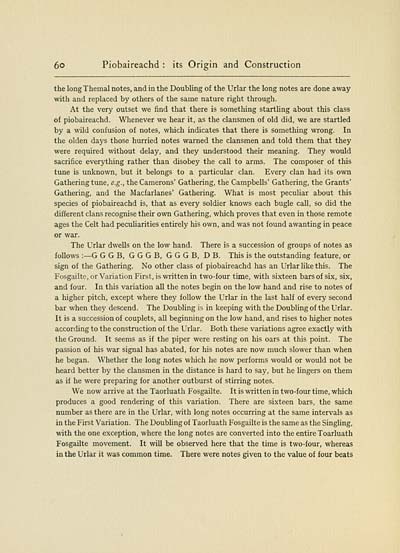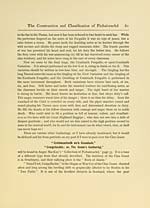Download files
Complete book:
Individual page:
Thumbnail gallery: Grid view | List view

6o Piobaireachd : its Origin and Construction
the longThemal notes, and in the Doubling of the Urlar the long notes are done away
with and replaced by others of the same nature right through.
At the very outset we find that there is something startling about this class
of piobaireachd. Whenever we hear it, as the clansmen of old did, we are startled
by a wild confusion of notes, which indicates that there is something wrong. In
the olden days those hurried notes warned the clansmen and told them that they
were required without delay, and they understood their meaning. They would
sacrifice everything rather than disobey the call to arms. The composer of this
tune is unknown, but it belongs to a particular clan. Every clan had its own
Gathering tune, e.g., theCamerons' Gathering, the Campbells' Gathering, the Grants'
Gathering, and the Macfarlanes' Gathering. What is most peculiar about this
species of piobaireachd is, that as every soldier knows each bugle call, so did the
different clans recognise their own Gathering, which proves that even in those remote
ages the Celt had peculiarities entirely his own, and was not found awanting in peace
or war.
The Urlar dwells on the low hand. There is a succession of groups of notes as
follows :— G G G B, G G G B, G G G B, D B. This is the outstanding feature, or
sign of the Gathering. No other class of piobaireachd has an Urlar like this. The
Fosgailte, or Variation First, is written in two-four time, with sixteen bars of six, six,
and four. In this variation all the notes begin on the low hand and rise to notes of
a higher pitch, except where they follow the Urlar in the last half of every second
bar when they descend. The Doubling is in keeping with the Doubling of the Urlar.
It is a succession of couplets, all beginning on the low hand, and rises to higher notes
according to the construction of the Urlar. Both these variations agree exactly with
the Ground. It seems as if the piper were resting on his oars at this point. The
passion of his war signal has abated, for his notes are now much slower than when
he began. Whether the long notes which he now performs would or would not be
heard better by the clansmen in the distance is hard to say, but he hngers on them
as if he were preparing for another outburst of stirring notes.
We now arrive at the Taorluath Fosgailte. It is written in two-four time, which
produces a good rendering of this variation. There are sixteen bars, the same
number as there are in the Urlar, with long notes occurring at the same intervals as
in the First Variation. The Doubling of Taorluath Fosgailte is the same as the SingHng,
with the one exception, where the long notes are converted into the entire Toarluath
Fosgailte movement. It will be observed here that the time is two-four, whereas
in the Urlar it was common time. There were notes given to the value of four beats
the longThemal notes, and in the Doubling of the Urlar the long notes are done away
with and replaced by others of the same nature right through.
At the very outset we find that there is something startling about this class
of piobaireachd. Whenever we hear it, as the clansmen of old did, we are startled
by a wild confusion of notes, which indicates that there is something wrong. In
the olden days those hurried notes warned the clansmen and told them that they
were required without delay, and they understood their meaning. They would
sacrifice everything rather than disobey the call to arms. The composer of this
tune is unknown, but it belongs to a particular clan. Every clan had its own
Gathering tune, e.g., theCamerons' Gathering, the Campbells' Gathering, the Grants'
Gathering, and the Macfarlanes' Gathering. What is most peculiar about this
species of piobaireachd is, that as every soldier knows each bugle call, so did the
different clans recognise their own Gathering, which proves that even in those remote
ages the Celt had peculiarities entirely his own, and was not found awanting in peace
or war.
The Urlar dwells on the low hand. There is a succession of groups of notes as
follows :— G G G B, G G G B, G G G B, D B. This is the outstanding feature, or
sign of the Gathering. No other class of piobaireachd has an Urlar like this. The
Fosgailte, or Variation First, is written in two-four time, with sixteen bars of six, six,
and four. In this variation all the notes begin on the low hand and rise to notes of
a higher pitch, except where they follow the Urlar in the last half of every second
bar when they descend. The Doubling is in keeping with the Doubling of the Urlar.
It is a succession of couplets, all beginning on the low hand, and rises to higher notes
according to the construction of the Urlar. Both these variations agree exactly with
the Ground. It seems as if the piper were resting on his oars at this point. The
passion of his war signal has abated, for his notes are now much slower than when
he began. Whether the long notes which he now performs would or would not be
heard better by the clansmen in the distance is hard to say, but he hngers on them
as if he were preparing for another outburst of stirring notes.
We now arrive at the Taorluath Fosgailte. It is written in two-four time, which
produces a good rendering of this variation. There are sixteen bars, the same
number as there are in the Urlar, with long notes occurring at the same intervals as
in the First Variation. The Doubling of Taorluath Fosgailte is the same as the SingHng,
with the one exception, where the long notes are converted into the entire Toarluath
Fosgailte movement. It will be observed here that the time is two-four, whereas
in the Urlar it was common time. There were notes given to the value of four beats
Set display mode to: Large image | Transcription
Images and transcriptions on this page, including medium image downloads, may be used under the Creative Commons Attribution 4.0 International Licence unless otherwise stated. ![]()
| Early Gaelic Book Collections > Hew Morrison Collection > Piobaireachd > (66) |
|---|
| Permanent URL | https://digital.nls.uk/81164709 |
|---|
| Description | A selection of items from a collection of 320 volumes and 30 pamphlets of literary and religious works in Scottish Gaelic. From the personal library of Hew Morrison, the first City Librarian of Edinburgh. |
|---|
| Description | Selected items from five 'Special and Named Printed Collections'. Includes books in Gaelic and other Celtic languages, works about the Gaels, their languages, literature, culture and history. |
|---|

